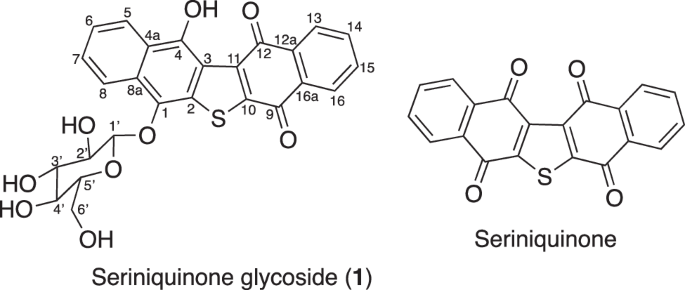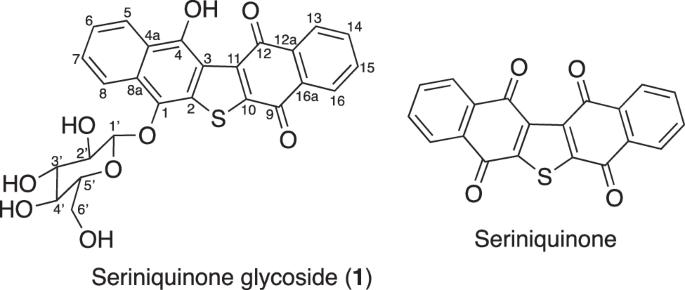利用深海地衣芽孢杆菌 KDM612 进行生物转化,获得新的丝氨酮苷。
IF 2.1
4区 医学
Q3 BIOTECHNOLOGY & APPLIED MICROBIOLOGY
引用次数: 0
摘要
丝氨醌是2014年从海洋源细菌Serinicoccus marinus CNJ927的培养液中分离出来的一种黑色素瘤选择性抗癌剂。它的靶点是影响癌细胞耐药性的独特小蛋白--dermcidin。由于其对癌细胞(尤其是黑色素瘤)的显著活性及其独特的靶点,丝氨醌已被开发为一种新的药源。然而,它在药物发现研究中存在溶解性差的缺点,亟待解决。利用深海地衣芽孢杆菌 KDM612 对丝氨酸醌进行生物转化,合成了一种新的丝氨酸醌糖苷(1)。化合物 1 对黑色素瘤具有选择性抗癌活性,与丝氨醌相似,在二甲基亚砜中的溶解度是丝氨醌的 50 倍。本文章由计算机程序翻译,如有差异,请以英文原文为准。


The new seriniquinone glycoside by biological transformation using the deep sea-derived bacterium Bacillus licheniformis KDM612
Seriniquinone was isolated as a melanoma-selective anti-cancer agent from a culture broth of the marine-derived bacterium Serinicoccus marinus CNJ927 in 2014. It targets the unique small protein, dermcidin, which affects the drug resistance of cancer cells. Due to its significant activity against cancer cells, particularly melanoma, and its unique target, seriniquinone has been developed as a new pharmacophore. However, it has the disadvantage of poor solubility in drug discovery research, which needs to be resolved. A new seriniquinone glycoside (1) was synthesized by the biological transformation of seriniquinone using the deep sea-derived bacterium Bacillus licheniformis KDM612. Compound 1 exhibited selective anti-cancer activity against melanoma, similar to seriniquinone, and was 50-fold more soluble in DMSO than seriniquinone.
求助全文
通过发布文献求助,成功后即可免费获取论文全文。
去求助
来源期刊

Journal of Antibiotics
医学-免疫学
CiteScore
6.60
自引率
3.00%
发文量
87
审稿时长
1 months
期刊介绍:
The Journal of Antibiotics seeks to promote research on antibiotics and related types of biologically active substances and publishes Articles, Review Articles, Brief Communication, Correspondence and other specially commissioned reports. The Journal of Antibiotics accepts papers on biochemical, chemical, microbiological and pharmacological studies. However, studies regarding human therapy do not fall under the journal’s scope. Contributions regarding recently discovered antibiotics and biologically active microbial products are particularly encouraged. Topics of particular interest within the journal''s scope include, but are not limited to, those listed below:
Discovery of new antibiotics and related types of biologically active substances
Production, isolation, characterization, structural elucidation, chemical synthesis and derivatization, biological activities, mechanisms of action, and structure-activity relationships of antibiotics and related types of biologically active substances
Biosynthesis, bioconversion, taxonomy and genetic studies on producing microorganisms, as well as improvement of production of antibiotics and related types of biologically active substances
Novel physical, chemical, biochemical, microbiological or pharmacological methods for detection, assay, determination, structural elucidation and evaluation of antibiotics and related types of biologically active substances
Newly found properties, mechanisms of action and resistance-development of antibiotics and related types of biologically active substances.
 求助内容:
求助内容: 应助结果提醒方式:
应助结果提醒方式:


